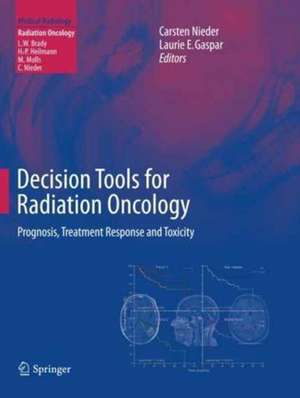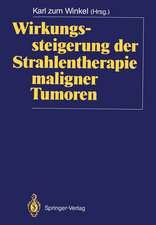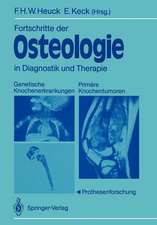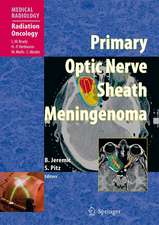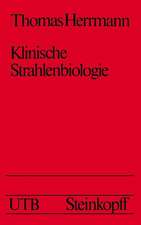Decision Tools for Radiation Oncology: Prognosis, Treatment Response and Toxicity: Medical Radiology
Editat de Carsten Nieder, Laurie E. Gasparen Limba Engleză Paperback – oct 2016
| Toate formatele și edițiile | Preț | Express |
|---|---|---|
| Paperback (1) | 733.56 lei 39-44 zile | |
| Springer Berlin, Heidelberg – oct 2016 | 733.56 lei 39-44 zile | |
| Hardback (1) | 1122.58 lei 3-5 săpt. | |
| Springer Berlin, Heidelberg – 3 apr 2014 | 1122.58 lei 3-5 săpt. |
Din seria Medical Radiology
- 5%
 Preț: 1108.87 lei
Preț: 1108.87 lei - 5%
 Preț: 349.23 lei
Preț: 349.23 lei - 5%
 Preț: 1308.02 lei
Preț: 1308.02 lei - 5%
 Preț: 1308.74 lei
Preț: 1308.74 lei - 5%
 Preț: 720.68 lei
Preț: 720.68 lei - 5%
 Preț: 717.20 lei
Preț: 717.20 lei - 5%
 Preț: 1626.03 lei
Preț: 1626.03 lei - 5%
 Preț: 1618.70 lei
Preț: 1618.70 lei - 5%
 Preț: 802.21 lei
Preț: 802.21 lei - 5%
 Preț: 1130.07 lei
Preț: 1130.07 lei - 5%
 Preț: 1116.00 lei
Preț: 1116.00 lei - 5%
 Preț: 1953.34 lei
Preț: 1953.34 lei - 5%
 Preț: 783.04 lei
Preț: 783.04 lei - 5%
 Preț: 1105.61 lei
Preț: 1105.61 lei - 5%
 Preț: 794.00 lei
Preț: 794.00 lei - 5%
 Preț: 1101.21 lei
Preț: 1101.21 lei - 5%
 Preț: 821.18 lei
Preț: 821.18 lei - 5%
 Preț: 1420.29 lei
Preț: 1420.29 lei - 5%
 Preț: 743.16 lei
Preț: 743.16 lei - 5%
 Preț: 906.63 lei
Preț: 906.63 lei - 5%
 Preț: 1313.72 lei
Preț: 1313.72 lei - 5%
 Preț: 1858.27 lei
Preț: 1858.27 lei - 5%
 Preț: 1306.73 lei
Preț: 1306.73 lei - 5%
 Preț: 1113.11 lei
Preț: 1113.11 lei - 5%
 Preț: 1462.37 lei
Preț: 1462.37 lei - 5%
 Preț: 1301.44 lei
Preț: 1301.44 lei - 5%
 Preț: 975.17 lei
Preț: 975.17 lei - 5%
 Preț: 1122.58 lei
Preț: 1122.58 lei - 5%
 Preț: 1986.27 lei
Preț: 1986.27 lei - 5%
 Preț: 1126.82 lei
Preț: 1126.82 lei - 5%
 Preț: 718.46 lei
Preț: 718.46 lei - 5%
 Preț: 1450.84 lei
Preț: 1450.84 lei - 5%
 Preț: 1298.14 lei
Preț: 1298.14 lei - 5%
 Preț: 1110.32 lei
Preț: 1110.32 lei - 5%
 Preț: 1184.42 lei
Preț: 1184.42 lei - 5%
 Preț: 1113.99 lei
Preț: 1113.99 lei - 5%
 Preț: 1435.85 lei
Preț: 1435.85 lei - 5%
 Preț: 663.23 lei
Preț: 663.23 lei - 5%
 Preț: 1605.08 lei
Preț: 1605.08 lei - 5%
 Preț: 731.07 lei
Preț: 731.07 lei - 5%
 Preț: 733.09 lei
Preț: 733.09 lei - 5%
 Preț: 1124.07 lei
Preț: 1124.07 lei - 5%
 Preț: 383.93 lei
Preț: 383.93 lei - 5%
 Preț: 1106.69 lei
Preț: 1106.69 lei - 5%
 Preț: 982.50 lei
Preț: 982.50 lei - 5%
 Preț: 1317.17 lei
Preț: 1317.17 lei - 5%
 Preț: 1437.67 lei
Preț: 1437.67 lei - 5%
 Preț: 1307.85 lei
Preț: 1307.85 lei - 5%
 Preț: 1950.60 lei
Preț: 1950.60 lei
Preț: 733.56 lei
Preț vechi: 772.17 lei
-5% Nou
Puncte Express: 1100
Preț estimativ în valută:
140.37€ • 146.85$ • 116.60£
140.37€ • 146.85$ • 116.60£
Carte tipărită la comandă
Livrare economică 31 martie-05 aprilie
Preluare comenzi: 021 569.72.76
Specificații
ISBN-13: 9783662522653
ISBN-10: 3662522659
Pagini: 318
Ilustrații: XIII, 305 p. 90 illus., 45 illus. in color.
Dimensiuni: 210 x 279 x 22 mm
Ediția:2014
Editura: Springer Berlin, Heidelberg
Colecția Springer
Seriile Medical Radiology, Radiation Oncology
Locul publicării:Berlin, Heidelberg, Germany
ISBN-10: 3662522659
Pagini: 318
Ilustrații: XIII, 305 p. 90 illus., 45 illus. in color.
Dimensiuni: 210 x 279 x 22 mm
Ediția:2014
Editura: Springer Berlin, Heidelberg
Colecția Springer
Seriile Medical Radiology, Radiation Oncology
Locul publicării:Berlin, Heidelberg, Germany
Cuprins
Prognosis and Predictive Factors for Tumours and Organs at risk: Background and Purpose.- Specific issues for prognostic factors related to radiotherapy.- Role of ICT in decision models.- Statistics of Prediction of survival and toxicity and Nomogram Development.- Treatment decisions based on Gene Signatures: Methods and Caveats.- Brain tumors.- Head and neck cancer.- Breast cancer.- Lung cancer.- Esophageal cancer.- Gastric cancer.- Pancreas and biliary tract cancer.- Liver cancer and metastases.- Rectal and anal cancer.- Cervix and corpus uteri, vulva and vaginal cancers.- Bladder cancer.- Prostate cancer.- Sarcomas.- Lymphomas.- Brain metastases.- Bone metastases.
Recenzii
“The textbook ‘Decision Tools for Radiation Oncology’ represents a laudable international effort in updating practicing clinicians as well as clinicians-in-training on the novel developments in the field of radiation oncology with a special focus on decision tools and nomograms, bringing data on new biomarkers and novel imaging techniques, and teaching the readers how best to incorporate various patient and tumor-specific characteristics into the discussion of radiation therapy benefits and shortcomings.” (Timur Mitin, Journal of Radiation Oncology, Vol. 4, 2015)
Textul de pe ultima copertă
A look at the recent oncology literature or a search of one of the common databases reveals a steadily increasing number of nomograms and other prognostic models, some of which are also available in the form of web-based tools. These models may predict the risk of relapse, lymphatic spread of a given malignancy, toxicity, survival, etc. Pathology information, gene signatures, and clinical data may all be used to compute the models. This trend reflects increasingly individualized treatment concepts and also the need for approaches that achieve a favorable balance between effectiveness and side-effects. Moreover, optimal resource utilization requires prognostic knowledge, for example to avoid lengthy and aggressive treatment courses in patients with a short survival expectation. In order to avoid misuse, it is important to understand the limits and caveats of prognostic and predictive models. This book provides a comprehensive overview of such decision tools for radiation oncology, stratified by disease site, which will enable readers to make informed choices in daily clinical practice and to critically follow the future development of new tools in the field.
Caracteristici
Comprehensive overview of prognostic and predictive models for radiation oncology, stratified by disease site Identification of models’ limits and caveats Excellent aid to decision making in daily clinical practice Includes supplementary material: sn.pub/extras
